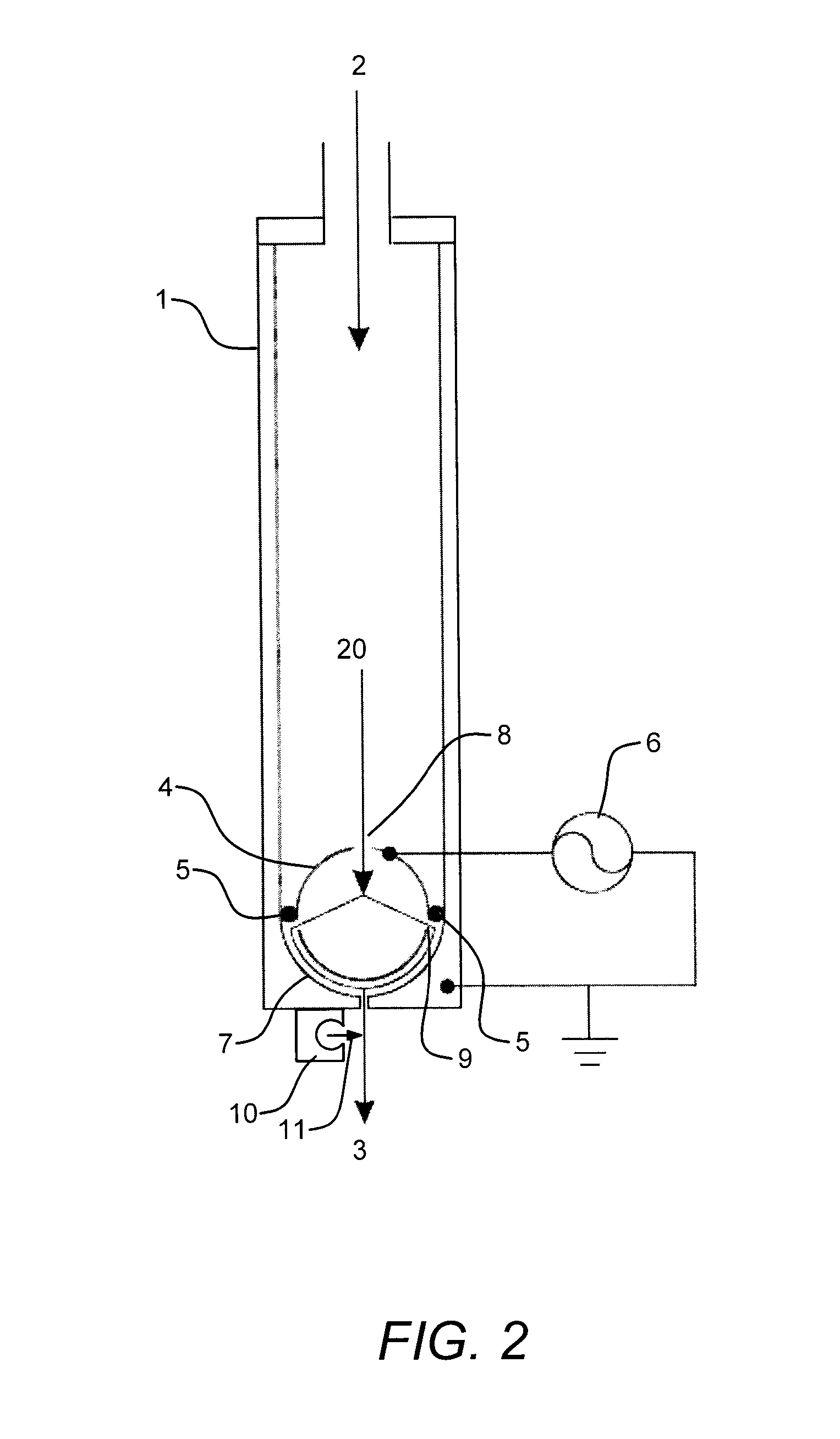Low-temperature, converging, reactive gas source and method of use
- Summary
- Abstract
- Description
- Claims
- Application Information
AI Technical Summary
Benefits of technology
Problems solved by technology
Method used
Image
Examples
example 1
Surface Activation
[0061]The apparatus shown in FIG. 1 was used to activate the surface of plastic materials. A mixture of helium at 30.0 L / min and oxygen at 1.5 L / min was fed into the rectangular housing. The plasma was struck in the device by applying radio frequency power at 250 W and 27.12 MHz. The plastic was placed 1.0 cm downstream of the outlet of the housing, and the housing was scanned over the sample at a constant rate. Before and after plasma treatment, the surface energy of each material was measured with ACCUDYNE Test markers. The results of these experiments are shown in TABLE 1.
[0062]
TABLE 1Surface activation of plastic samples.Surface energy (dyne / cm)Scan rateExposureSubstrateInitialFinal(cm / s)time (s)Polypropylene3270+1.30.06Nylon4670+2.50.03Silicone rubber3070+1.30.06ABS4270+1.30.06HDPE3870+0.60.13
[0063]A surface energy greater than 70 dyne / cm means that the sample surface is hydrophilic, and that a water droplet will spread out flat on it. On polypropylene, silico...
example 2
[0064]The present invention may be used to etch materials. For example KAPTON may be etched by exposure to the oxygen plasma, whereas silicate glass and tantalum may be etched by exposure to a fluorine and oxygen plasma. The apparatus presented in FIG. 1 was used to etch KAPTON films, 50 microns thick, at the following conditions: 30 L / min helium, 0.5 to 2.0 L / min oxygen, 270 W RF power, and 0.5 cm distance from the device outlet to the film. Shown in TABLE 2 below is the effect of the oxygen flow rate on the etch rate of the KAPTON film. The etch rate increases gradually with the oxygen flow rate from 1.4 microns per second at 0.5 L / min to 2.8 microns per second at 2.0 L / min. Note that the temperature of the gas exiting the plasma device increases with the oxygen flow rate from about 280 to 350° C., and this may be partly responsible for the increase in etch rate. Nevertheless, the rapid etch rate observed with the low-temperature, atmospheric pressure plasma demonstr...
example 3
Deposition of Thin Films
[0067]The apparatus shown in FIG. 2 was used to deposit glass films on silicon wafers. A mixture of helium at 30 L / min and oxygen at 1.5 L / min was fed into the plasma device, while 250 W of RF power at 27.12 MHz was supplied to generate the discharge. Hexamethyldisiloxane was dispersed into helium carrier gas and introduced to the apparatus through the precursor distributor located 1.0 mm away from the outlet of the duct. A silicon wafer, 10.0 cm in diameter, was placed on a holder 5.0 mm downstream of the distributor, and spun at a rate of ˜150 RPM. Listed in TABLE 3 is the dependence of the average thickness of the glass film on the substrate exposure time. The average deposition rate is shown in the third column of the Table, which is calculated by dividing the average film thickness by the time and multiplying this quantity by the area of the wafer (78.5 cm2) divided by the area of the plasma beam (0.4 cm2).
[0068]
TABLE 3Deposition of glass films with the ...
PUM
| Property | Measurement | Unit |
|---|---|---|
| Length | aaaaa | aaaaa |
| Length | aaaaa | aaaaa |
| Temperature | aaaaa | aaaaa |
Abstract
Description
Claims
Application Information
 Login to View More
Login to View More - R&D
- Intellectual Property
- Life Sciences
- Materials
- Tech Scout
- Unparalleled Data Quality
- Higher Quality Content
- 60% Fewer Hallucinations
Browse by: Latest US Patents, China's latest patents, Technical Efficacy Thesaurus, Application Domain, Technology Topic, Popular Technical Reports.
© 2025 PatSnap. All rights reserved.Legal|Privacy policy|Modern Slavery Act Transparency Statement|Sitemap|About US| Contact US: help@patsnap.com



